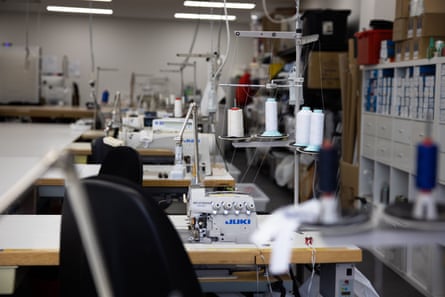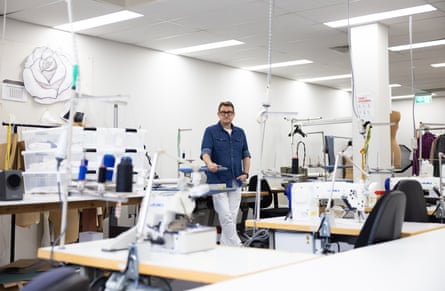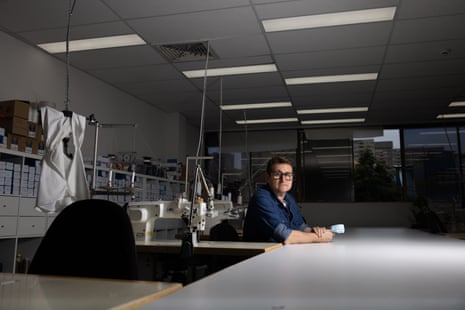When coronavirus hit international fashion manufacturing centres last year, many Australian designers pivoted to making clothes onshore. But as Sydney’s lockdown extends into the second half of 2021, garment factories are struggling to stay open and the long-term viability of manufacturing in Australia is under threat.
Sydney’s inner west is usually a busy hub of clothing manufacturing. But the machinists who power this industry often commute in from the city’s south west, an area subject to the strictest lockdown orders in New South Wales.
According to the rules, people are allowed to leave home to go to work if they cannot work from home, but the fashion industry relies on the skill and talent of a workforce largely made up of female migrants, who are not comfortable travelling in the midst of a health crisis. The net effect is empty factories and stalled production of next season’s collections.

At the end of July, Christiaan Kidd found himself without staff and had to close his business, The Fashion Production Company. He has 11 employees, most of whom are over 55 and live in hotspot areas. He says, understandably, they are “too scared to get on public transport and come to work”, even if they have been vaccinated.
Kidd’s assistant, who asked not to be named, came to Australia from Vietnam 10 years ago. She is in regular contact with the machinists Kidd employs. “Most of us live in the west of Sydney which has a very high rate of Covid cases,” she says. Most have chosen not to work during the current lockdown because “they’re afraid they might bring Covid-19 home”.
She describes the pandemic as a frightening and precarious time. “We all feel like we’re in the dark … we don’t know what’s going to happen and they fear the factory can’t last through the lockdown, it might shut down. They fear they might lose their jobs.”

Bianca Spender, a prominent Australian fashion designer, says the garment makers she works with have expressed similar fears. She says a lot of her makers “are the matriarch in their family, they look after grandchildren, they’re often carers for parents. They’re not just garment workers, that’s just one of the hats they wear.
“Understandably, there is a lot of fear, because if they get sick, their whole family gets sick.”
Spender is an advocate for local manufacturing and has maintained production in Sydney since she launched her label 10 years ago. She says, “by manufacturing in Australia, we have been able to be nimble and dynamic and react to the current climate”.
This agility is key to the survival of young brands in an ever-competitive industry, she says. “Maintaining production in Australia is integral to our industry’s growth and development.”
The halt to operations could not come at a worse time, Spender says. “Summer is our peak season and this is the time for manufacturing these collections. It hurts us as designers, it hurts retailers, and it hurts makers. This is when they make the money that sustains the business for the whole year.”
Amrik Sohal, a professor at Monash University and the director of the Australian Supply Chain Management Research Unit, says there will be a serious impact on the Australian garment manufacturing industry if Sydney’s lockdown extends for a number of months.
He says the industry runs more efficiently when manufacturing is local because it means designers can easily interact with the people developing their products. “If you send manufacturing overseas it adds micro-complexities within the supply chain,” he says – this can lead to issues like quality control and lags in delivery times.
Charlotte Hicks, the designer and founder of Esse Studios, is struggling to get her next collection made. Her business is in its third year, and was just starting to build momentum with retail partners in Europe and North America. She spent 2020 working hard to nurture relationships with international stockists, which could be impossible to re-establish if she is unable to deliver on their orders. “It is really hard to think, here we are again, with the possibility of having to break those ties,” she says.
Hicks is passionate about manufacturing in Australia. She is concerned the current outbreak could “kill off the whole industry very quickly” because as long as the factories aren’t operational, brands will be forced to take production offshore in order to meet their commitments to retailers. Once the jobs and skills are gone, she believes it will be difficult to bring them back.
Sohal says there are currently two opposing forces impacting the long-term prospects of Australia’s garment manufacturing. On the one hand, he says, due to the disruption of the pandemic, supply chains are becoming more regionally focused. But on the other, advancements in technology in factories in Bangladesh and China mean that making clothes offshore will become so cheap and efficient that a shift to offshore manufacturing is inevitable – barring more disruptions from global pandemics.

Australian garment manufacturers, like Kidd, are experiencing this market volatility in real time. Last year, supply chain issues caused designers to turn to local manufacturing. This was great for businesses like Kidd’s. “We booked out many months in advance and it was quite fantastic,” he says.
But the rise in interest highlighted another issue – a lack of education and training. “There is a finite number of skilled workers in Australia who can make garments to a standard high enough that we can charge the prices we need to charge.” He says there is “no one coming along behind them with the skills and training to replace them”.
Under the financial strain of the latest outbreak, he is thinking about closing permanently. “I don’t know what the best thing to do is right now. Rent still needs to be paid, electricity still needs to be paid, the bills need to be paid.”
For Spender this is deeply concerning. “In terms of the makers, who have very small businesses that are vulnerable to such a huge hit, they’re all made out of immigrant and refugee populations and we have an obligation to make sure there is an industry after lockdown for these communities.”
She says the government needs to step in “to financially support these businesses so there is a long-term future and a healthy clothing manufacturing industry in Australia”.
